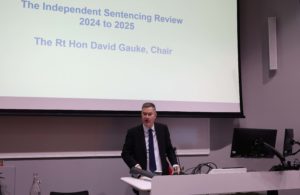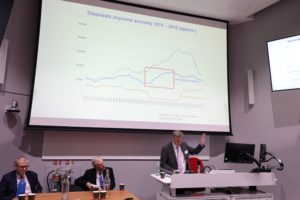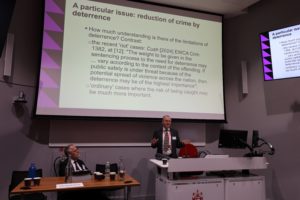These notes of the seminar are not a verbatim record of the day, nor do they cover every point raised and may (despite our best efforts) contain inaccuracies.
Welcome
Professor Peter Hungerford-Welch, The City Law School
Professor Peter Hungerford-Welch opened the seminar, welcomed attendees, and outlined the role and work of the City Law School.
Opening remarks
The Rt Hon the Baroness Carr of Walton-on-the-Hill, The Lady Chief Justice of England and Wales
The Rt Hon Lord Justice William Davis, Chair of the Sentencing Council for England and Wales

The Rt Hon the Baroness Carr of Walton-on-the-Hill, The Lady Chief Justice of England and Wales provided some opening remarks as President of the Sentencing Council.
She welcomed the opportunity to speak at the conference before outlining the background to sentencing guidelines and the Sentencing Council, as well as the achievements of the Council to date and the way in which it works. She also stated that the judiciary welcomes the Independent Sentencing Review led by The Rt Hon David Gauke.
The Rt Hon Lord Justice William Davis, Chair of the Sentencing Council for England and Wales, thanked the Lady Chief Justice for her contribution to the event. He also thanked all the speakers and attendees for their input to the day before introducing the first session, on victims and sentencing.
Victims and sentencing
Panel discussion with HHJ Amanda Rippon, Sentencing Council member and Dr Jay Gormley, University of Glasgow
Session chaired by Johanna Robinson, Sentencing Council member and National Advisor to the Welsh Government on Violence against Women, Domestic Abuse and Sexual Violence
Johanna Robinson (JR) gave an overview of her role as the Sentencing Council’s victims representative and National Advisor to the Welsh Government on Violence against Women, Domestic Abuse and Sexual Violence. HHJ Rippon (AR) also gave an overview of her role and experience in the judiciary and Dr Gormley (JG) described his background and experience, which has included working with the Sentencing Council, the Scottish Sentencing Council, academics and practitioners.
Points raised in the discussion
- JR highlighted the need to understand what a victim’s motivation is and consider terminology (for example ‘victim’ or ‘survivor’) and whether anything could depersonalise experiences. JG commented that in research it is common to ask the person which term they prefer, as different terms may mean different things to different people. It’s important to be mindful of sensitivities, give people a voice, and allow them to be heard.
- JR flagged that victims want their experience to be validated – this is about showing the person respect, giving them time and understanding. Victims do not want the type of offending they experienced to happen again and so there is a need to be honest about whether it is likely to happen. JG commented that victims may not desire the most severe sentence available; they may perceive that a better outcome is keeping other people safe.
- Victims can experience trauma in terms of potentially blanking out a period of their life and being judged (for example in terms of their responses during the offence, and being challenged during police interviews and then in court).

Dr Jay Gormley, Amanda Rippon HHJ, Johanna Robinson - An audience member commented that rape victims find the court process very traumatising and that there have been various measures introduced to help them give evidence. There are also pilots in relation to independent legal advice for victims and free access to sentencing transcripts for victims of some offences. JR responded that measures in place work and make a difference to the victim and how much they commit to the process – this includes Section 28 (pre-recorded cross-examination), having an advocate, giving a person time and space, and not having delays in the process.
- Victims want to be informed; they often do not understand how long the criminal justice process takes and the different elements within it. It would potentially be helpful to have one point of contact throughout the whole process (although there are resource issues associated with this). JG also highlighted that there is a large diversity among victims, and understanding of the process may not be clear to everyone – for example sentencing options available and what a particular sentence means/involves.
- JG also commented that sentencing can be very important to a victim, but other things also have an impact on them – for example, whether there were delays with getting to trial, whether the victim had an input into the process etc. Sentencing is not insignificant, but making sure victims feel they’ve been listened to requires not just the right sentence but also something else – for example, that they feel the offender has been held to account, that the harm they’ve suffered has been taken into account, and that the process and sentence have been explained sufficiently to them.
- Victims generally don’t observe the whole court process and are not encouraged to do so. JR questioned whether this might serve to distance people from their own experience.
- The length of cases might also impact on victims’ everyday life – during the case, victims might see their offender or their family if they live in their community. People need support around how to stay safe in the community.
- AR mentioned that she has dealt with cases where Victim Personal Statements (VPS) have mentioned how delays in the process have compounded the distress and harm that the victim has suffered. However, it is important to remember that the defendant is not responsible for the procedural delays. The judge can acknowledge the harm caused to the victim by any delay but cannot take that into account as an aggravating factor when sentencing if the delay is not the fault of the offender.

Dr Jay Gormley, Amanda Rippon HHJ, Johanna Robinson - An audience member asked how a person being sentenced in absentia would impact on the issue of a victim feeling validated by the sentencing process. JR noted that this was an important issue for victims and many victim groups have made the case that that the practice of sentencing without the offender in court should not be allowed: it can be seen as an easy way of them not having to face the shame and outcome of their offence. The offender needs to have accountability. In addition, if the victim can’t see the offender’s face during the sentencing remarks, how can they visualise them being handed their sentence? Most victims will want evidence that this person is going to change, and the offender being in court is part of that.
- AR pointed out that in England and Wales an offender in custody is required to attend their sentence hearing – it is not a choice. Sometimes defendants refuse to come to court, although in her experience this was rare. The judge can require the Prison Service to bring the defendant to court (or to a video link room) using appropriate measures, without risking harm (including, for example, to prison staff), but before doing so the prison would have to carry out a risk assessment. If the offender cannot be got into court or on a video link, the judge could adjourn the sentencing hearing to try to secure their presence, but would take into account the views of any victims either attending court for the hearing or waiting anxiously for the result elsewhere – a delay could cause significant distress and it may be better to proceed with the absent defendant in those circumstances.
- An audience member asked about cases where prosecutions go ahead against the wishes of the victim. AR commented that victims are not required to provide VPS and only do so if they want to. Sometimes other family members can provide a VPS instead. Judges often sentence cases without any. If victims produce one, it is helpful, but it is not essential. Sentencing guidelines always include harm intrinsic to any offence, so harm is always taken into account. Victims are never expected to behave in a particular way, as trauma affects people differently.
- An audience member asked whether there’s too much responsibility on the victim to produce a ‘good’ VPS for sentencing. AR commented that the victim is not responsible for this, and judges often sentence cases without one. If victims produce one, it is helpful, but it is not essential. Sentencing guidelines include harm factors, so the harm involved will be taken into account. Victims are never expected to behave in a particular way as trauma affects people differently.
- The tone and content of the judges’ sentencing remarks is very important. It is important that an explanation is given for the sentence, but there is a sense that understanding is perhaps lacking. This raises the question of how we might better communicate to survivors about what has happened and what the sentence involves. Sentencing guidelines also play a part because victims should not be given unrealistic expectations.
Session on the Sentencing Review
The Rt Hon David Gauke (DG), Chair to the Independent Sentencing Review
Session chaired by The Rt Hon Lord Justice William Davis, Chair of the Sentencing Council for England and Wales
- The Rt Hon David Gauke (DG), Chair to the Independent Sentencing Review, opened the session, outlining the background to the Review and its remit. He covered the members of the panel, all of whom have a wealth of knowledge and experience to contribute, and some of whom attended the seminar.
- DG’s opening remarks covered the prison capacity crisis, the government’s implementation of the Standard Determinate Sentences (SDS40) measure, the inability to build new prisons fast enough to address the problems, and the potential for further capacity crises in coming years. It was also highlighted that although sentencing policy has contributed to driving up demand for prison places, issues around remand places are also relevant (although this is outside the scope of the Review), and there is a need to consider the impact of short-custodial sentences.
- DG flagged the need to set realistic expectations: any recommendations need to be deliverable and consider how best to use resources effectively. A report from the Review is due to be published this spring and implemented by spring 2026, taking account for the need for measures to potentially be included in legislation this summer.
Points raised in the audience discussion
- The current Crown Court backlog and whether there will be any impact from the provision for magistrates to sentence up to 12 months’ imprisonment on single either-way offences: could the result be more people receiving shorter sentences? DG commented that the Review would be looking at short custodial sentences and taking an evidence-based approach.
- The increase in the prison population (rates of custodial sentences and average custodial sentence lengths) is a result of intention, as governments have introduced increases in the statutory maximum sentences for some offences. It was suggested that there is a need to recalibrate the statutory maxima. DG acknowledged the role of the government/Parliament in driving up demand for prison places and the fact that the introduction of new offences/increased sentences often means the effect is actually felt by a future government. Another member of the audience also reiterated the impact of creating new offences, citing the offence of assault on an emergency worker, which has seen maximum sentences increase over time.

The Rt Hon David Gauke - The role of the Sentencing Council: some evaluations of guidelines have found there to have been unexpected increases in prison places; for some guidelines, the Council has made changes, but for others (e.g. burglary) it did not. Lord Justice William Davis (LJD) acknowledged that the Sentencing Council has not sought to dampen down sentences often and that it will usually draw on current sentencing practice when developing a guideline and will wish to reflect Parliament’s wishes in terms of sentencing (for example, the increases in sentences for death by dangerous driving offences).
- The impact of the media and the fact that strategies can be undermined by it at times. DG commented that it is a challenging media environment, and a defensible case will need to be made for radical reform.
- Another audience member raised issues around value for money, flagging that this argument is less well received in the area of justice than in other areas (for example, health) and whether there needs to be a body set up to constrain government (for example, similar to the National Institute for Health and Care Excellence). DG responded around the role of politicians in leadership and the need to make the case that punishment is not only served through custodial sentences and that there are other disposals that constitute punishment.
- The impact of families of victims who lobby to increase sentences in some areas, particularly life sentences. DG commented that it is important that the families of victims are listened to. However, there are issues around coherence in sentencing policy and we need to have a more coherent system going forward.
- The potential need to replicate the success that has been achieved in the youth justice system: reoffending rates have reduced and there is a focus on the welfare of the offender. LJD commented that despite some media reports and public perceptions around ‘soft’ sentences, community orders also often impose significant restrictions on an offender.
- The resources required for non-custodial options and the input of the Probation Service into these. Judges need coherence in community sentences. DG commented that recommendations around community sentences need to consider the practical implications on the Probation Service and the current context.
- Release provisions: comments included the potential for flexible risk assessments for young adults who continue to develop through their 20s. DG commented that risk assessments need to be thorough and there should be caution against releasing existing serious offenders.
Research presentation: Research review on effectiveness of sentencing
Dr Jay Gormley, University of Glasgow
Session chaired by Professor Peter Hungerford-Welch, The City Law School
Dr Jay Gormley (JG) presented key findings from his research reviews on the effectiveness of sentencing, which were published in 2022 and 2024 and commissioned by the Sentencing Council.
Key points covered included:
- What ‘effectiveness’ means is multi-dimensional and depends on whom you ask.
- The 2022 review focussed on the effectiveness of different sentencing options on reducing reoffending, as well as cost effectiveness.
- There is a correlation between age and crime; data indicates that offending peaks at ages 18-20.
- Some of the factors that can help to reduce reoffending include social relationships and housing. Alcohol and drug treatment requirement options can also help where the offender has an addiction.
- Evidence suggests some sentencing options can make an offender more likely to reoffend, e.g. short custodial sentences.
- The 2024 review covered four perspectives on the effectiveness of sentencing: from victims, offenders, the public, and sentencers.
- The research found that the sentence outcome imposed is not the only factor that is important to the victim. For example, victims also want the offender to be held accountable.

Dr Jay Gormley - Offenders need to understand the sentence they have been given and the reasons behind it. Punishment also depends on how the offender perceives different disposals.
- Fines are often used for low-level offences and there is a question on how punitive they are. However, research shows that fines can be very effective in some cases. Sometimes community orders can be more onerous than a prison sentence.
- There is sometimes a difference between the public’s view of sentencing and what is actually happening, e.g. there is a perception that sentencing has become more lenient, but it has actually become more severe.
- Sentencers: it is important to understand what sentencing options are effective according to sentencers. Sentencers themselves need to have confidence in the sentence options in order to impose them.
- JG’s work involving focus groups found that participants expressed that some of the aims of sentencing should be to: deliver proportionate punishment; rehabilitate and address the causes of offending; deter people from offending; hold offenders to account; show victims justice has been done; repair harms.
- There is a need to identify any gaps in sentencing options, e.g. disposals that are not currently being used or not used often.
Issues covered in the audience discussion
- That the sentence imposed, and how it is communicated, should hold the offender to account. It can also be useful for someone to sit down with the offender after court and explain the sentence they have been given. Release provisions in particular tend to be complicated and confusing.
- How should sentencing be communicated: Focus groups conducted with the public found that most information on sentencing comes from the media. The Council already do a lot of work to increase public knowledge of sentencing.
- The media often selects the most sensational cases to report and can have an agenda around the perception that sentencing is too lenient. The Council should continue to explain sentencing information in accessible ways, such as through ‘You be the Judge’.
- There is information available on the reoffending rate for offenders who received a community order compared to that for those who received custodial sentences. It would also be helpful to have more information specifically on community orders – for example, reoffending rates by the level of community order.
- It is important that sentencers have confidence in the sentencing options available. We need more data on what works and what does not.
Sentence inflation: what are the solutions?
Ollie Simpson, Office of the Sentencing Council
Panel discussion with Rob Allen, independent researcher
Session chaired by Professor Julian Roberts, KC (Hon), Sentencing Academy and University of Oxford
Ollie Simpson (OS) presented data relating to sentence disposals between 1970 and 2015, as well as custodial sentences imposed between 2013 and 2023. He outlined some potential drivers of longer sentences over these periods, including in particular increases to maximum penalties, statutory aggravating factors and other legislative changes, before flagging some issues to consider in relation to sentence inflation. These included the need for political will to make changes, whether any changes to sentencing guidelines are needed, the impact of murder sentences under Schedule 21 on sentences for other offences, and the fact there are unlikely to be any ‘quick fixes’.
Points raised in discussion
- Professor Julian Roberts (JR) mentioned work being undertaken at Leeds University to consider the issue of sentence inflation. This found that some of the inflation for some offences was accounted for in terms of case mix and an increase in the seriousness of the offences before the court. Inflation also occurs due to legislative changes – changes in statutory maximum sentences or higher minimum starting points.
- A representative from the Office of the Scottish Sentencing Council commented that Scotland also has issues with sentence inflation, but for different reasons (for example they have no statutory aggravating factors and no equivalent to Schedule 21).
- Whether full impact assessments are undertaken by the MoJ before legislative changes are brought in and whether the Sentencing Council could look to assess and cost new legislation.
- Rob Allen (RA) questioned whether there would be concern over incarceration rates if there were prison places available. He also asked why there needs to be a link between sentences for murder and other offences.

Rob Allen, Prof Julian Roberts, Ollie Simpson - RA asked whether starting points in sentencing guidelines could be recalibrated, whether there could be reductions in maximum sentences, and whether more steps should be incorporated into guidelines to decrease sentences. He also felt previous discretion around previous convictions should be restored (it is now a statutory aggravating factor) and that there could be more out-of-court disposals. A member of the audience suggested that reducing statutory maximums is not a long-term fix for those cases where a much higher sentence is necessary and may lead to new offences being introduced. She also highlighted potential problems with out-of-court disposals: for example, if this is a high fine and the individual is not able to pay it, they will then end up in court for breach of their sentence.
- Guilty pleas: an audience member highlighted that there are many people without legal representation, which means not everyone is advised to provide an early guilty plea. RA also questioned whether guilty plea reductions could be increased to help with sentence inflation.
- Another audience member felt there is not enough public understanding around sentencing and it should be included in the education system.
The purposes of sentencing
Professor Peter Hungerford-Welch, The City Law School
Session chaired by Steve Wade, Head of Office of the Sentencing Council
Professor Peter Hungerford-Welch (PHW) outlined the five purposes of sentencing in England and Wales: the punishment of offenders; the reduction of crime; reform/ rehabilitation of offenders; protection of the public; reparation by offenders to those affected. He commented that these purposes are not presented in any priority order and in some cases are contradictory (for example, protection of the public may be achieved by sentencing offenders to custody, but it is then difficult for them to make reparations).
PHW went on to outline that Scotland does not have statutory purposes, but in 2018 set out principles that are broadly similar to those in England and Wales, but with some differences in content and language: protection; punishment (articulated as normally involving ‘some sort of loss’); rehabilitation; giving offenders the opportunity to make amends; the expression of disapproval of offending behaviour.
PHW then posed several questions to the audience. Discussion points in relation to these, as well as other issues, included:
- Whether there should be more detailed guidance on how to prioritise the different purposes of sentencing. Contributions from the audience included that cases may be too fact-specific to prioritise and that it is difficult to see how this would work in practice.
- Whether sentencers should state the highest priority purpose of sentencing in their sentencing remarks: some felt this would be problematic, especially as sentencing is quite nuanced and because it could remove judicial discretion. LJD also commented that in his experience, judges deal with matters fully and lay out what they are trying to achieve by the sentence, even if they are not explicitly stating the purpose. An audience member agreed and felt that judges demonstrate the purpose of sentencing through the sentence they give and that knowledge of how the sentencer reached the sentence gives you the information on the purposes they were considering. Another felt that asking sentencers to go through the purposes would be excessive and potentially not helpful for the public.
- What is deterrence in sentencing? Penalties increase on the basis that they will make the world safer, but there is a public lack of faith in sentencing. People are also often deterred more by the chance of apprehension for an offence. Therefore, is deterrence overplayed, given its limited impact (and should it be removed as part of the purposes of sentencing?) or did the sentences around the riots in Southport indicate some impact of deterrent sentencing? Comments from the audience included: the fact that the impact of the riot sentencing is not clear cut and it is too soon to have an evidence base regarding this; that there is generally a weight of evidence against deterrence having an impact; that sentencing is nuanced (for example, white collar criminals could in theory look at the guideline sentences and make a choice around their offending); that there are differences between general deterrence and that in relation to individuals; and that in the youth court there is an umbrella term to ‘reduce reoffending and have regard to welfare’ which encompasses all of the purposes of sentencing.

Prof Peter Hungerford-Welch, Steve Wade - Knowledge of the purposes of sentencing: does the public know the purposes of sentencing, and do they agree? Should public debate be linked more closely to the purposes (e.g. as part of the current Sentencing Review?). In term of politics, it was suggested that only the purpose of punishment seems to matter.
- Whether ancillary orders could help play a part in the achieving the purposes of sentencing? PHW commented that sentencing is more than custodial sentences and that ancillary orders are part of the sentencing package. However, he did caution that breaches of new orders could lead to immediate custody.
Close
Steve Wade, Head of Office of the Sentencing Council
Steve Wade summarised the main points from the conference, highlighting the breadth of the discussion in the different sessions. He thanked all the speakers, chairs of sessions and attendees for their contributions and input to the day.